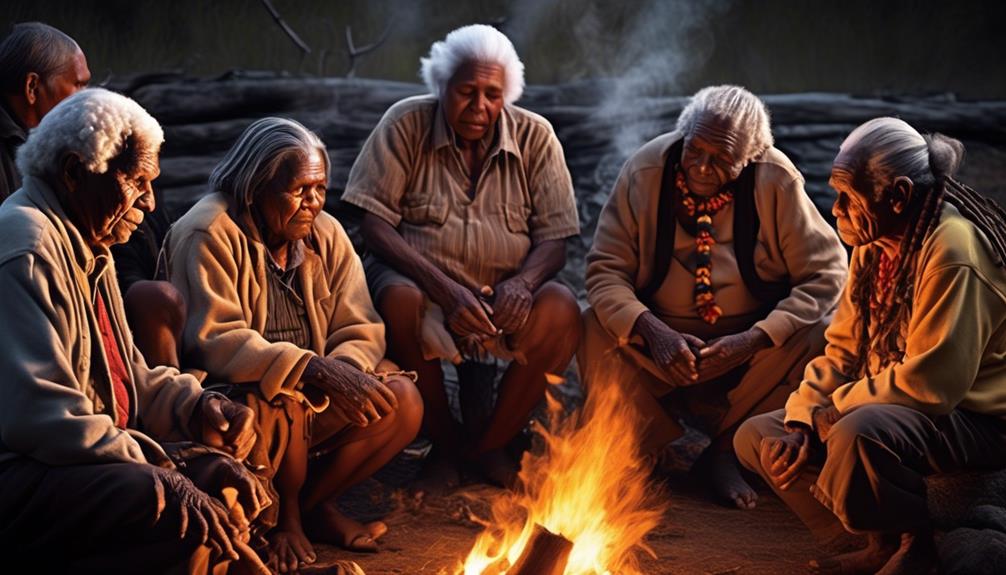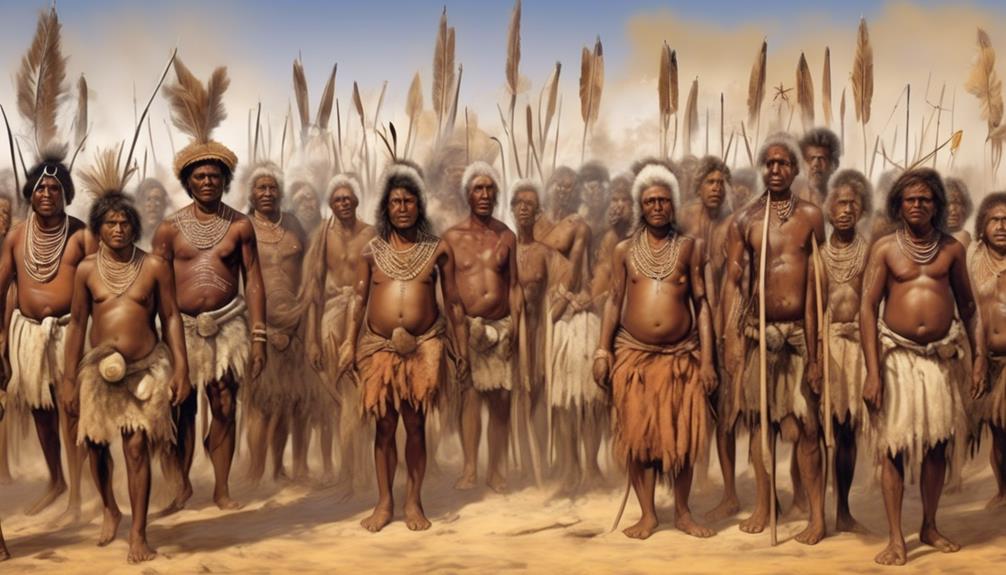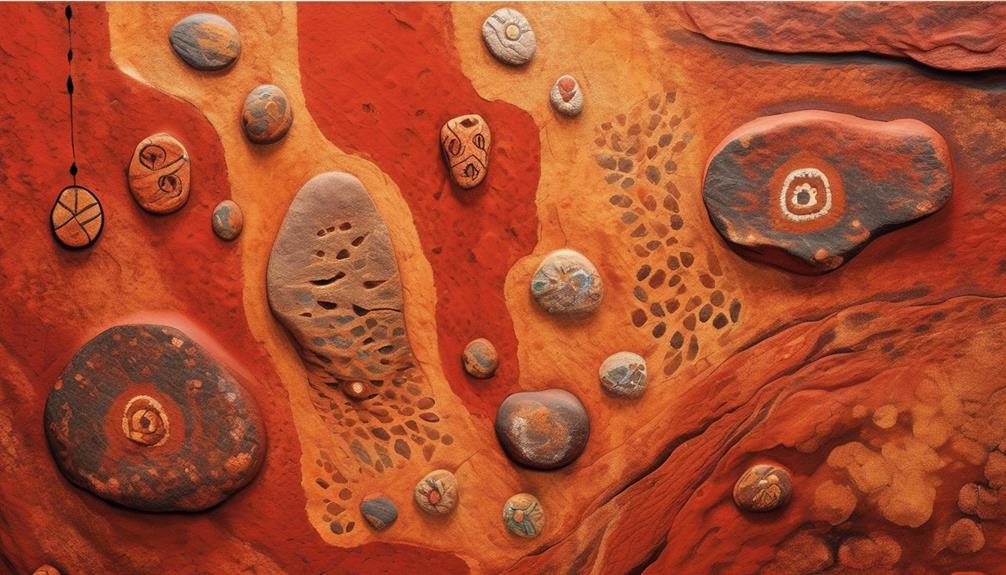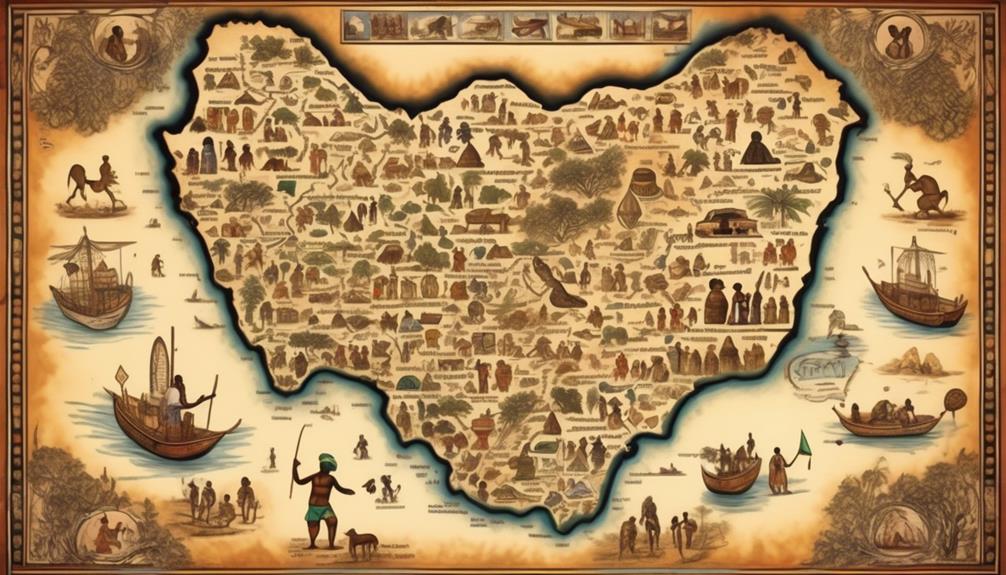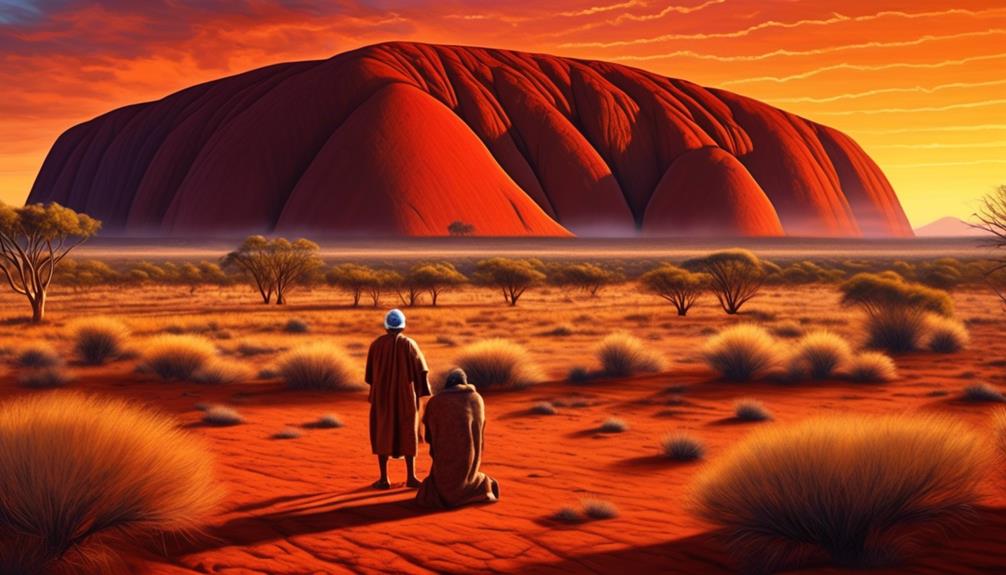Numerous individuals might not realize the deep and intricate importance that Aboriginal symbols represent in Indigenous Australian culture. These symbols go beyond mere decoration; they embody rich spiritual and cultural connotations that have been transmitted across generations.
From the origins of these symbols to their contemporary interpretations, the journey of Aboriginal symbols is a fascinating exploration of tradition, art, and identity. Understanding the symbolism behind these ancient marks provides a unique insight into the rich tapestry of Indigenous Australian heritage.
Key Takeaways
- Aboriginal symbols have a rich cultural history that dates back thousands of years.
- They serve as a means of cultural preservation, passing down profound meanings and stories through generations.
- Traditional Aboriginal art uses symbols and patterns to convey stories of creation, land, and ancestral beings.
- Aboriginal symbols continue to play a significant role in expressing the cultural heritage of Indigenous communities.
Origins of Aboriginal Symbols
The origins of Aboriginal symbols can be traced back through thousands of years of rich cultural history, revealing deep connections to the land, spirituality, and traditional ways of life. Within the historical context of Aboriginal culture, these symbols have served as a means of cultural preservation, carrying profound meanings and stories that are passed down through generations. The significance of these symbols lies in their ability to convey complex narratives, spiritual beliefs, and connections to the natural world.
In exploring the historical context of Aboriginal symbols, we gain a deeper understanding of the ways in which these symbols have played a fundamental role in preserving and sharing the cultural traditions of Indigenous communities. The symbols aren't merely decorative; they embody the essence of Aboriginal identity, reflecting a profound respect for the land and the wisdom of their ancestors.
As we delve into the origins of Aboriginal symbols, we recognize the importance of acknowledging and respecting the cultural significance embedded within these timeless representations. It's through this understanding that we can truly appreciate the depth of meaning and historical importance encapsulated within these symbols.
Symbolism in Traditional Art
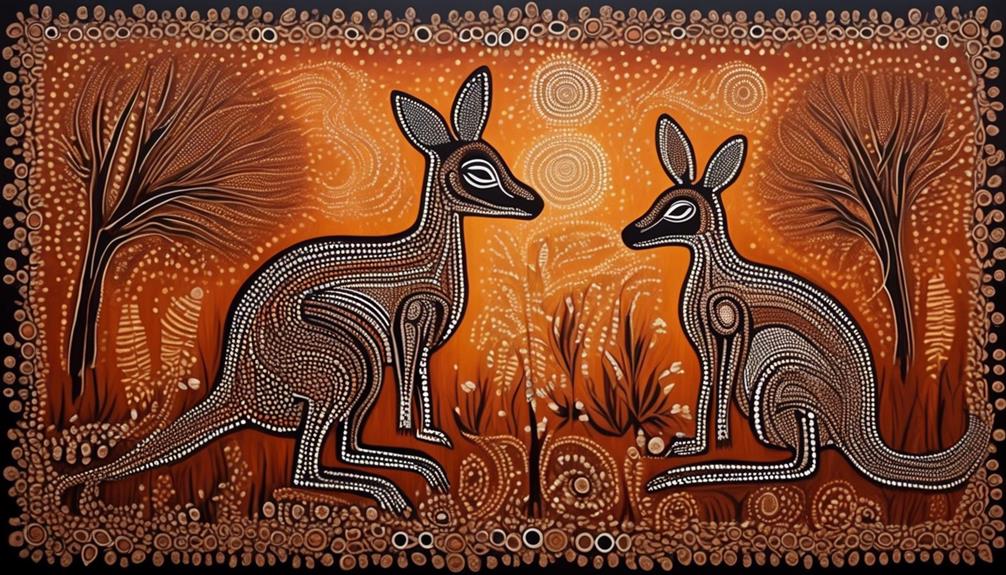
Delving into the realm of traditional Aboriginal art reveals a profound use of symbolism that intricately weaves together narratives, spiritual beliefs, and connections to the natural world. Traditional art in indigenous cultures serves as a visual language, conveying stories of creation, land, and ancestral beings. The symbols and patterns used in these artworks carry deep cultural significance, reflecting the interconnectedness of the Aboriginal people with their environment and their spirituality. To better understand the symbolism embedded in traditional Aboriginal art, let's explore some common elements and their meanings in the table below:
| Symbol | Meaning |
|---|---|
| Waterholes | Sustenance and life |
| Campfires | Gathering place and community |
| Serpent | Creative and regenerative force |
Each stroke, dot, or line in traditional art is purposeful, holding layers of meaning that connect the present with the past. As observers, it is essential to approach these artworks with respect and an understanding of the cultural depth embedded within them. Traditional art in indigenous cultures not only serves as a form of creative expression but also as a reservoir of knowledge and tradition.
Spiritual and Cultural Significance
Exploring the spiritual and cultural significance of traditional Aboriginal symbols reveals a rich tapestry of interconnected narratives and beliefs that are deeply rooted in the natural world. Symbolic storytelling is integral to the Aboriginal culture, as these symbols are imbued with profound meanings that convey stories of creation, spirituality, and the interconnectedness of all living things. Each symbol holds layers of significance, often passed down through generations via oral traditions and visual representations. These symbols aren't merely decorative; they're repositories of wisdom, carrying the knowledge of the land, ancestors, and spiritual beliefs.
Sacred ceremonies play a pivotal role in Aboriginal culture, where these symbols are utilized to connect with the spiritual realm, seek guidance, and honor the interconnectedness of all life. During these ceremonies, traditional symbols are employed to depict and celebrate the Dreamtime, ancestral spirits, and natural elements. The use of symbols in these sacred rituals reinforces the continuity of cultural practices and fosters a deep reverence for the land and its stories.
The spiritual and cultural significance of traditional Aboriginal symbols is a testament to the profound wisdom and enduring legacy of this ancient culture.
Evolution of Aboriginal Symbols
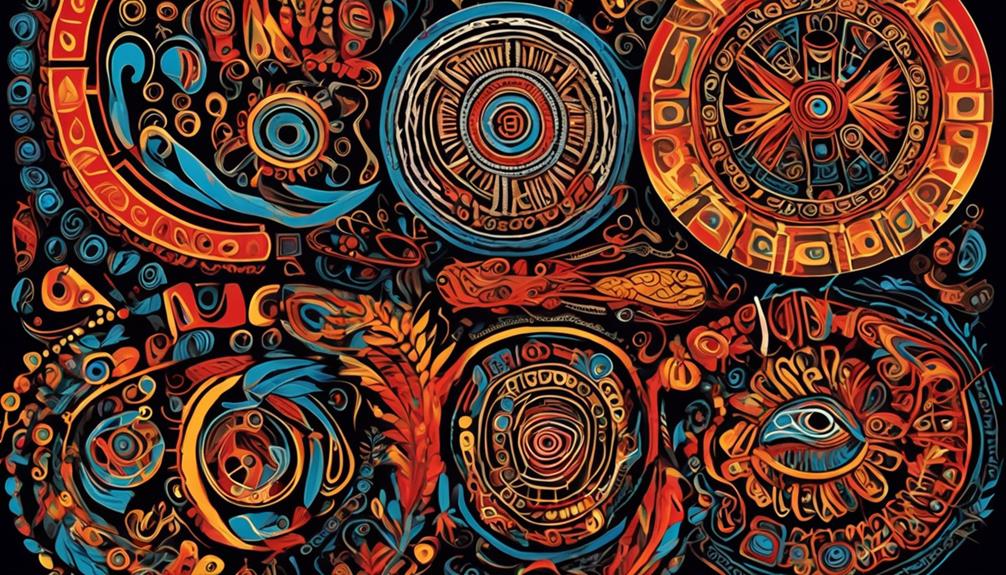
Through our examination of the historical and cultural narratives, we can discern the gradual transformation and adaptation of traditional Aboriginal symbols over time. The evolution of Aboriginal symbols is deeply intertwined with the cultural evolution of Indigenous communities. As these communities have experienced changes in their social, spiritual, and environmental contexts, their artistic expression has also evolved. This evolution isn't a linear process; rather, it's a complex interplay of continuity and innovation.
Artistic expression among Aboriginal communities has always been a way to convey cultural knowledge, spirituality, and connections to the land. Over time, the symbolism within Aboriginal art has adapted to reflect the changing experiences and perspectives of the community. Traditional symbols have been reinterpreted, and new symbols have emerged to communicate contemporary stories and experiences.
The evolution of Aboriginal symbols is a testament to the resilience and adaptability of Indigenous cultures. It highlights the ongoing significance of artistic expression as a means of preserving cultural heritage while also allowing for dynamic and relevant storytelling. This evolution enriches the cultural tapestry of Indigenous communities and fosters a deeper understanding of their diverse experiences.
Contemporary Use and Interpretation
The contemporary use and interpretation of Aboriginal symbols reflect the ongoing evolution of Indigenous artistic expression and its relevance to modern cultural narratives. In today's context, Aboriginal symbols continue to play a significant role in expressing the rich cultural heritage of Indigenous communities. Modern interpretation of these symbols involves a dynamic blend of traditional and contemporary artistic expressions, showcasing the adaptability and timelessness of Aboriginal art.
Artists are incorporating these symbols into various forms of visual art, including paintings, sculptures, and digital media, to convey powerful messages that resonate with current societal issues and personal experiences.
The artistic expression of Aboriginal symbols in the contemporary world serves as a bridge between the past and the present, allowing for the continuation of cultural storytelling and the celebration of Indigenous identity. The modern interpretation of these symbols also offers a platform for dialogue and understanding, inviting people from diverse backgrounds to engage with and appreciate the depth of Aboriginal artistry.
As we navigate the complexities of today's world, the enduring significance of Aboriginal symbols in artistic expression serves as a testament to the enduring legacy and relevance of Indigenous culture.
Frequently Asked Questions
How Do Different Aboriginal Communities Interpret and Use Symbols in Their Art and Culture?
We notice interpretation differences in how various communities use symbols. Symbolic significance varies, reflecting cultural adaptation and artistic expression.
These differences enrich our understanding of diverse traditions and beliefs. It's fascinating to see how each community imbues symbols with unique meanings, reflecting their distinct cultural and historical contexts.
This diversity adds depth and complexity to the rich tapestry of Aboriginal art and culture.
Are There Any Specific Rules or Guidelines for Creating New Symbols Within Aboriginal Art and Culture?
When creating symbols within aboriginal art and culture, guidelines are often based on cultural significance and community representation. These symbols are deeply rooted in artistic interpretations and carry rich meanings.
Our understanding of these rules comes from our respect for the traditions and the stories passed down through generations. It's important to approach the creation of new symbols with a deep appreciation for the diverse and intricate nature of aboriginal cultures.
What Role Do Aboriginal Symbols Play in Modern Indigenous Activism and Social Movements?
In the realm of modern activism, indigenous symbols have taken on a powerful role. These symbols serve as a visual language, carrying the weight of cultural interpretation and oral traditions.
Their creation and use in activism are integral to reclaiming and preserving indigenous identity. However, the interpretation and use of these symbols must be approached with sensitivity and respect, especially when navigating taboo symbols.
How Are Aboriginal Symbols Used in Storytelling and Oral Traditions Within Indigenous Communities?
In our indigenous communities, storytelling holds a central place in passing down traditions and knowledge.
Interpretation of symbolism in storytelling is key to understanding our traditional oral traditions.
Traditional indigenous art often incorporates these symbols, further preserving our cultural narratives.
It's essential for us to honor and continue these practices, as they reflect our history, values, and spiritual beliefs.
Are There Any Taboos or Restrictions Around the Use of Certain Symbols Within Aboriginal Culture?
When it comes to cultural appropriation, it's crucial to understand the significance of symbolic representation.
In many indigenous cultures, there are taboos and restrictions around the use of certain symbols. It's essential to respect these cultural boundaries and seek permission before using any symbols that hold deep meaning within a community.
Conclusion
In conclusion, Aboriginal symbols have a rich history and deep cultural significance.
As we continue to explore and interpret these symbols, we're reminded of their enduring importance in Indigenous communities.
Just like the intricate dot paintings that tell stories of creation and connection to the land, Aboriginal symbols serve as a bridge between the past and the present.
They guide us to a better understanding of the diverse and meaningful traditions of the First Nations people.
Talise is a talented writer and an expert in her field. Her unique perspective and insights enrich our content with depth and authenticity. With a wealth of knowledge and a strong connection to the subjects she writes about, Talise crafts engaging and informative articles that resonate with our readers. Her dedication to bringing Indigenous culture and wisdom to light is truly commendable.

